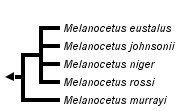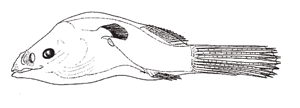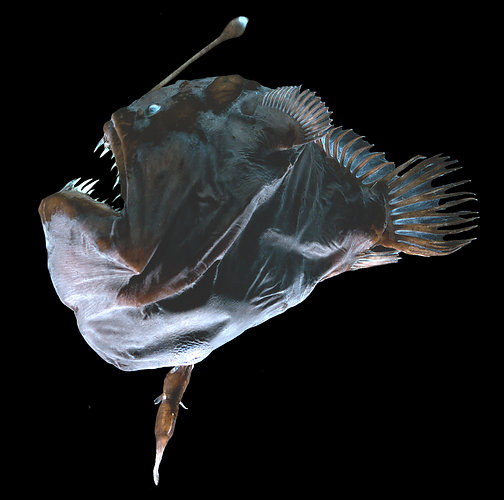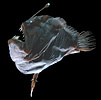Melanocetidae
Melanocetus
Black Seadevils
Theodore W. Pietsch


This tree diagram shows the relationships between several groups of organisms.
The root of the current tree connects the organisms featured in this tree to their containing group and the rest of the Tree of Life. The basal branching point in the tree represents the ancestor of the other groups in the tree. This ancestor diversified over time into several descendent subgroups, which are represented as internal nodes and terminal taxa to the right.

You can click on the root to travel down the Tree of Life all the way to the root of all Life, and you can click on the names of descendent subgroups to travel up the Tree of Life all the way to individual species.
For more information on ToL tree formatting, please see Interpreting the Tree or Classification. To learn more about phylogenetic trees, please visit our Phylogenetic Biology pages.
close boxIntroduction
The family Melanocetidae includes globose bathypelagic anglerfishes, easily separated from members of allied families by having a combination of features that includes 12 or more dorsal-fin rays, three to five anal-fin rays, a huge mouth, and numerous long fang-like teeth (Bertelsen, 1951; Pietsch, 1972a; Pietsch and Van Duzer, 1980). The only currently recognized genus of the family was established by Günther (1864) with the description of Melanocetus johnsonii, based on a single female specimen collected in the Atlantic Ocean off Madeira. Since that time, 13 additional species based on females have been described. The family currently includes six recognized species (Pietsch and Van Duzer,1980; Balushkin and Fedorov, 1981)
Characteristics
Diagnosis
Metamorphosed males and females of the family Melanocetidae are distinguished from those of all other ceratioid families by having a combination of 13-16 (rarely 12 or 17) dorsal-fin rays and 4 (rarely 3 or 5) anal-fin rays.
Metamorphosed females are further differentiated by having the following combination of character states: supraethmoid present; frontals widely separated, each with a prominent ventromedial extension; parietals present; sphenotic spines absent; pterosphenoid, metapterygoid, and mesopterygoid present; hyomandibular with a double head; hypohyals 2; branchiostegal rays 6 (2 , 4); opercle bifurcate, dorsal fork reduced; subopercle long and slender, as long as lower fork of opercle in some specimens, ventral part with a well-developed spine on anterior margin; quadrate, articular, angular, and preopercular spines absent; jaws equal anteriorly; lower jaw with a well-developed symphysial spine; postmaxillary process of premaxilla absent; anterior-maxillomandibular ligament absent; pharyngobranchials I and IV absent; pharyngobranchials II and III well developed and toothed; epibranchial I reduced; hypobranchials I-III well developed; a single ossified basibranchial; epibranchial and ceratobranchial teeth absent; epibranchial I and proximal one-half of ceratobranchial I bound to wall of pharynx by connective tissue; distal end of ceratobranchial I free, not bound by connective tissue to adjacent ceratobranchial II; proximal one-quarter to one-half of ceratobranchials II-IV not bound together by connective tissue; epurals absent; hypural plate entire, without posterior notch; pterygiophore of illicium bearing a small ossified remnant of second cephalic spine; escal bulb and central lumen present, esca without tooth-like denticles; posteroventral process of coracoid absent; pectoral radials 4, fusing to 3 with growth; pelvic bones expanded distally; pectoral-fin rays 15-23; pelvic fins absent; caudal-fin rays 9 (1 simple, 6 bifurcated, 2 simple); skin with minute widely spaced dermal spinules in at least some specimens (only visible microscopically in cleared and stained material; see Pietsch and Van Duzer, 1980:67); ovaries paired; pyloric caecae absent.


Free-living male of Melanocetus sp, ZMUC P92675. After Bertelsen (1951). © 1951, 1983 Bertelsen
Metamorphosed males are further differentiated in having the following combination of character states: eyes directed laterally, elliptical in shape, pupil larger than lens; olfactory organs large, nostrils lateral, inflated; nasal area unpigmented; 12-24 olfactory lamellae; jaw teeth absent; upper denticular with 2 or 3 semicircular series of strong recurved denticles, fused with a median series of 3-9 enlarged dermal spines that articulate with the pterygiophore of the illicium; lower denticular with 10-23 recurved denticles, fused into a median and two lateral groups; skin spinulose or naked; fin-ray counts as given for metamorphosed females; free-living, never parasitic, two known examples of males attached to females in temporary coupling (Pietsch, 2005).
Larvae are further differentiated in having the following combination of character states: body short, almost spherical; skin moderately inflated; pectoral fins of normal size, not reaching beyond dorsal and anal fins; pelvic fins absent; sexual dimorphism evident, females with a small, club-shaped illicial rudiment protruding from head; fin-ray counts as given for metamorphosed females; metamorphosis beginning at lengths of 8-10 mm SL (Bertelsen, 1951:45, 49, figs. 16A-G, 17A-F; 1984:326, 328, fig. 169C-D).
Description
Metamorphosed females with body short and deep, globular, depth 60-75% SL (but often appearing highly compressed due apparently to deformation following capture); head short; mouth large, opening oblique to nearly vertical, cleft not extending past eye; jaws equal anteriorly; oral valve weakly developed; two nostrils on each side on distal surface of a rounded papilla; eye small, subcutaneous, appearing through a circular translucent area of integument within a shallow orbital pit formed between sphenotic and frontal bones; teeth slender, recurved, and depressible, some slightly hooked distally, those in lower jaw less numerous (except in some small specimens, less than approximately 20 mm SL) but slightly longer than those in upper jaw; number of teeth in upper jaw 29-178, in lower jaw 32-142; longest tooth in lower jaw 6.9-25.0% SL; number of vomerine teeth 0-12; epibranchial I bound to wall of pharynx; epibranchials I-IV closely bound together; proximal one-half of ceratobranchial I bound to wall of pharynx, distal half free; epibranchial IV and ceratobranchial IV bound to wall of pharynx, no opening behind fourth arch; gill filaments absent on epibranchials, present on proximal tip of ceratobranchial I and full length of ceratobranchials II-IV; pseudobranch absent; length of illicium 23.1-60.8% SL; anteriormost tip of pterygiophore of illicium exposed, emerging on snout between eyes, posterior end concealed under skin; escal bulb simple, usually with a rounded or conical distal prolongation, and often with posterior and anterior crests; elongate escal appendages and filaments absent; neuromasts of acoustico-lateralis system located at tips of low cutaneous papillae, pattern of placement as described for other ceratioids (Pietsch, 1969, 1972b, 1974a, 1974b).
Color of metamorphosed females dark brown to black over entire surface of head and body (except for distal portion of escal bulb) and oral cavity; all fins white in specimens less than approximately 40 mm (except for caudal-fin rays of adolescent specimens of Melanocetus murrayi; Bertelsen, 1951:47, fig. 16I). Metamorphosed males with outer pigmentation as for females (except nasal area unpigmented), subdermal pigmentation variable (Bertelsen, 1951:42; Pietsch and Van Duzer, 1980:83).
The largest known female is a 135-mm specimen of M. johnsonii; the largest known metamorphosed male, also identified as M. johnsoni, measures 28 mm.
Discussion of Phylogenetic Relationships
The Melanocetidae appears to be a relatively primitive ceratioid family (Bertelsen 1951; Pietsch 1972a, 1976, 1979). The five species are characterized by a confusing mosaic of primitive and derived character states such that an interpretation of interspecific phylogenetic relationships is difficult. In any case, however, it seems apparent that M. murrayi has split off from the main line of melanocetid evolution and acquired a number of unique features that reflect its most derived position in the genus: 1) depressed cranium, 2) concave vomer, 3) small pectoral fin, 4) tiny escal bulb, and 5) thin integument. Living in considerably deeper strata than its congeners most probably also reflects a derived condition.
The four remaining species are much more closely related to each other than any is to M. murrayi. Five characters can be used to distinguish these forms: 1) number of lower jaw teeth, 2) longest lower jaw tooth, 3) illicium length, 4) escal bulb width, and 5) escal morphology. Unfortunately, all but the last of these characters overlap in variation among the remaining forms of the genus, and, furthermore, the relative primitiveness of character states among these features is nearly impossible to determine. Melanocetus johnsonii is perhaps derived in having a relatively long illicium, and in having fewer, but longer jaw teeth (see Pietsch 1972b, 1974a). Melanocetus polyactis and M. niger are similar in having relatively short jaw teeth, a similar escal morphology lacking anterior and posterior crests, and a sympatric geographic distribution that is restricted to the Gulf of Panama and adjacent eastern tropical Pacific. Melanocetus eustalus is derived in having an extremely large escal bulb, comparable to no other known ceratioid.
Distribution
Melanocetus johnsonii and M. murrayi, by far the best known species of the genus, have broad distributions, the former known from all three major oceans of the world, the latter from the Atlantic and Pacific. Melanocetus rossi is represented by a single specimen collected in the Ross Sea, Antarctica; M. polyactis and M. niger, known from 15 and six specimens, respectively, are both restricted to the eastern tropical Pacific; and M. eustales, is known from a single specimen collected in the eastern Pacific off Mazatlán, Mexico.
References
Balushkin, A. V., and V. V. Fedorov. 1981. On finding the deepwater anglerfishes (Melanocetus rossi sp. n. and Oneirodes notius) in the Ross Sea (Antarctica). Biologiya Morya, 2(2): 79–82. [In Russian, with English abstract.]
Bertelsen, E. 1951. The ceratioid fishes. Ontogeny, taxonomy, distribution and biology. Dana Rept., 39, 276 pp.
Bertelsen, E. 1980. Notes on Linophrynidae V: A revision of the deepsea anglerfishes of the Linophryne arborifer-group (Pisces, Ceratioidei). Steenstrupia, 6(6): 29–70.
Bertelsen, E. 1982. Notes on Linophrynidae VIII: A review of the genus Linophryne, with new records and descriptions of two new species. Steenstrupia, 8(3): 49–104.
Bertelsen, E. 1984. Ceratioidei: Development and relationships. pp. 325-334, In: Moser, H. G., W. J. Richards, D. M. Cohen, M. P. Fahay, A. W. Kendall, Jr., and S. L. Richardson (editors), Ontogeny and Systematics of Fishes, Spec. Publ. No. 1, Amer. Soc. Ichthy. Herpet., ix + 760 pp.
Günther, A. C. L. G. 1864. On a new genus of pediculate fish from the sea of Madeira. Proc. Zool. Soc. London, 1864(6): 301–303.
Pietsch, T. W. 1969. A remarkable new genus and species of deep-sea anglerfish (family Oneirodidae) from off Guadalupe Island, Mexico. Copeia, 1969(2): 365–369.
Pietsch, T. W. 1972a. A review of the monotypic deep-sea anglerfish family Centrophrynidae: Taxonomy, distribution, and osteology. Copeia, 1972(1):17–47.
Pietsch, T. W. 1972b. A second specimen of the deep-sea anglerfish, Phyllorhinichthys micractis (family Oneirodidae), with a histological description of the snout flaps. Copeia, 1972(2): 335–340.
Pietsch, T. W. 1974a. Osteology and relationships of ceratioid anglerfishes of the family Oneirodidae, with a review of the genus Oneirodes Lütken. Nat. Hist. Mus. L. A. Co., Sci. Bull., 18, 113 pp.
Pietsch, T. W. 1974b. Systematics and distribution of ceratioid anglerfishes of the genus Lophodolos (family Oneirodidae). Breviora, 425: 1–19.
Pietsch, T. W. 1979. Ceratioid anglerfishes of the family Caulophrynidae with the description of a new genus and species from the Banda Sea. Contrib. Sci., Nat. Hist. Mus. Los Angeles Co., 310: 1–25.
Pietsch, T. W. 2005. Dimorphism, parasitism, and sex revisited: modes of reproduction among deep-sea ceratioid anglerfishes (Teleostei: Lophiiformes). Ichthyol. Res., 52: 207–236.
Pietsch, T. W., and J. P. Van Duzer. 1980. Systematics and distribution of ceratioid anglerfishes of the family Melanocetidae, with description of a new species from the eastern North Pacific Ocean. U. S. Fish. Bull., 78(1): 59–87.
Title Illustrations

| Scientific Name | Melanocetus johnsonii |
|---|---|
| Location | Eeartern North Atlantic, off Ireland |
| Comments | 75-mm SL female with 23.5-mm attached male |
| Specimen Condition | Dead Specimen |
| Identified By | T. W. Pietsch |
| Sex | Male and Female |
| Life Cycle Stage | Adult |
| Collection | British Museum of Natural History |
| Copyright | © 2005 E. A. Widder |
About This Page
Theodore W. Pietsch

University of Washington, Seattle, Washington, USA
Correspondence regarding this page should be directed to Theodore W. Pietsch at
twp@u.washington.edu
and Christopher P. Kenaley at
ckenaley@u.washington.edu
Page copyright © 2005 Theodore W. Pietsch
 Page: Tree of Life
Melanocetidae. Melanocetus. Black Seadevils.
Authored by
Theodore W. Pietsch.
The TEXT of this page is licensed under the
Creative Commons Attribution-NonCommercial License - Version 3.0. Note that images and other media
featured on this page are each governed by their own license, and they may or may not be available
for reuse. Click on an image or a media link to access the media data window, which provides the
relevant licensing information. For the general terms and conditions of ToL material reuse and
redistribution, please see the Tree of Life Copyright
Policies.
Page: Tree of Life
Melanocetidae. Melanocetus. Black Seadevils.
Authored by
Theodore W. Pietsch.
The TEXT of this page is licensed under the
Creative Commons Attribution-NonCommercial License - Version 3.0. Note that images and other media
featured on this page are each governed by their own license, and they may or may not be available
for reuse. Click on an image or a media link to access the media data window, which provides the
relevant licensing information. For the general terms and conditions of ToL material reuse and
redistribution, please see the Tree of Life Copyright
Policies.
- First online 05 November 2005
Citing this page:
Pietsch, Theodore W. 2005. Melanocetidae. Melanocetus. Black Seadevils. Version 05 November 2005 (under construction). http://tolweb.org/Melanocetus/22003/2005.11.05 in The Tree of Life Web Project, http://tolweb.org/







 Go to quick links
Go to quick search
Go to navigation for this section of the ToL site
Go to detailed links for the ToL site
Go to quick links
Go to quick search
Go to navigation for this section of the ToL site
Go to detailed links for the ToL site